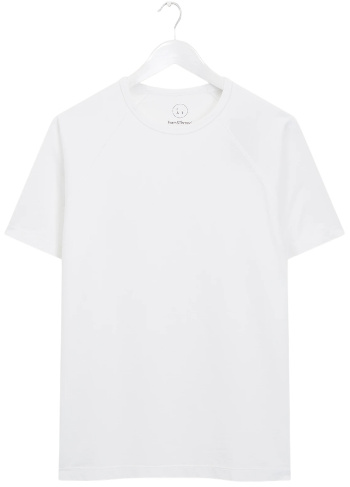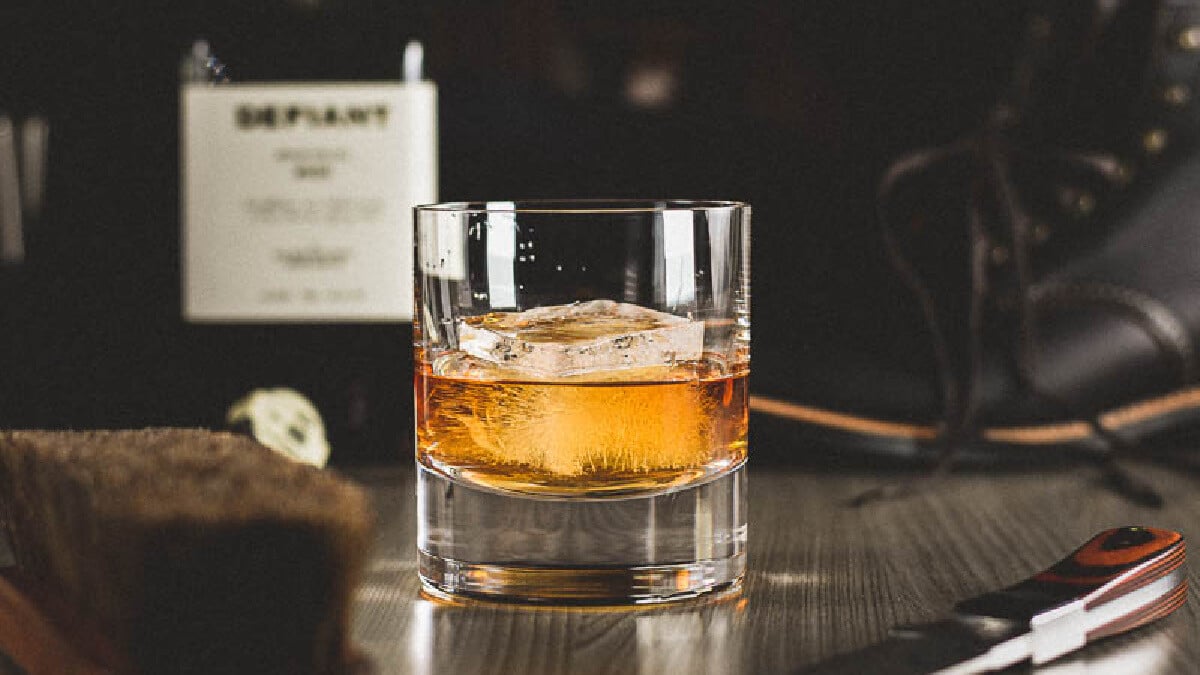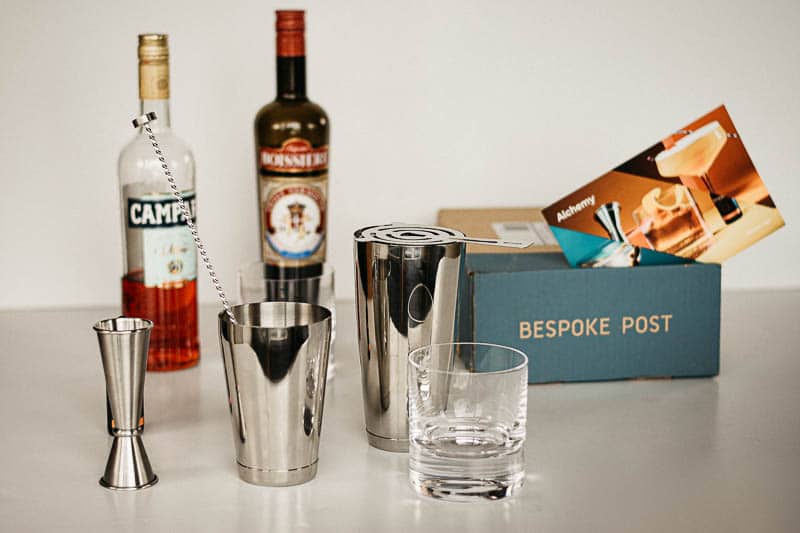What does scotch taste like?
A malty taste is common to all scotch because malted barley is the predominant ingredient. Scotch sometimes carries a striking smokey flavor if distillers use peat during kilning. The extent of this depends on the quantity of peat used. Maturing in a cask can introduce fruit and vanilla notes.
It’s interesting that most people consider scotch to be an acquired taste.
Because the industry is absolutely booming.
With whisky sales growing annually by 5.51% the global whisky market is estimated to be worth $84billion USD by 2025.
But you’re not here for numbers, you’re here for scotch. It’s a gentleman’s drink, and you want a taste of the action.
But what does scotch taste like?
Let’s educate your taste buds and escort you through your first dram.
It’s time to level up your knowledge of the ‘water of life’ and enjoy whisky like a connoisseur.
Pro tip: The word ‘dram’ is Scottish Gaelic for ‘drink’.
Skip Ahead
Scotch vs Whiskey: What’s the Difference?
For a whisky to earn the honorable tag of scotch, it must conform to the Scotch Whisky Order. These standards outline that the distillation process must take place at a Scottish distillery. Maturation also has to occur in Scotland within oak casts for at least three years.
So geography is the deciding factor, but that isn’t the only thing to differentiate a scotch from a whiskey.
Ingredients also play a part. Malted barley is the key ingredient in scotch whereas bourbon whiskey uses corn.
Have you ever pondered whether the spelling whisky or whiskey is correct? Not only are both spellings right, but the ‘e’ is significant in identifying where the bottle is from.
Scotland, Canada, and Japan all use the spelling without the ‘e’. Whereas referring to bottles distilled in the USA or Ireland, the spelling is whiskey with an ‘e’.
The Most Common Scotch Flavors
There are merely a few ingredients that combine to make scotch. And turning grains in a field into delicious alcohol in a bottle is surprisingly pretty straightforward.
So why are there different flavors?
Geography, climate, and small nuances in the raw materials can make a considerable difference to the flavor of the whiskey.
To further understand the flavors, let’s have a closer look at the production process.
How Scotch is Made
Malting is the initial stage where the scotch gains it’s malty taste. Whisky makers germinate the grains by steeping them in water and spreading them on a concrete floor. The starch within the barley converts into sugars, and alongside yeast, will create alcohol.
As the grains sprout, the germination process is withheld from developing further by drying the malt in a kiln.
When burning peat in the kiln the whisky develops a smokey flavor. The quantity of peat will determine the level of smokiness.
The subtle flavors of scotch develop during the maturation process. Flavors will depend on what type of oak and the preceding function of the casks. A European oak cast formerly employed for housing sherry or port will cause different undertones to an American oak cask used for bourbon.
An American cask previously used for bourbon can have notes of:
- Sweet toffee
- Vanilla
- Coconut
- Caramel
- Woody
A European oak cast formerly used for sherry can have notes of:
- Dark berries
- Cherry
- Dried fruit
- Dark chocolate
- Spice
How Different Brands of Popular Scotch Brands Taste
Now to look at some of the most popular scotch brands and their flavors.
There are 133 Scotch Whisky distilleries in Scotland, each bringing something different to the table. These are just a select few to get you started.
Glenlivet 12-Year-Old (Speyside)
12-year-old Glenlivet is a gentle single malt, perfect for a newcomer.
Glenlivet’s founder George Smith was quite the trailblazer. The remoteness of the Livet valley made it ideal grounds for illicit distillation. When illegal production was rife, he grasped the opportunity to go straight and was the first in the area to get a distiller’s license in 1824.
This didn’t go down well with fellow illegal distillers.
50 years later, George won the right to call his whisky The Glenlivet—sometimes you gotta do what you gotta do.
Glenlivet is the benchmark to all Speyside single malts to this very day.
This classic scotch is first matured in traditional European oak before moving to American oak casks. The double-barrel approach contributes to its bright appearance and smooth creamy finish.
When nosing this scotch you can expect fruit and summer aromas.
With fruity pineapple notes and warm vanilla flavor, it’s established itself as a go-to scotch.
Ardbeg 10-Year-Old (Islay)
Do you want the full peat experience?
Don’t drink this scotch beneath a smoke alarm because it’s as smoky as they come.
Admired across the globe as the peatiest and most intricate whisky in the world, Ardbeg is one for the budding connoisseur.
Revel in the aromas of smoked fish and crispy bacon before enjoying toasted marshmallows flavors.
As whisky expert Jim Murray says in The Complete Book of Whisky, “Unquestionably the greatest distillery to be found on Earth. If perfection on the palate exists, this is it.”
Jura 10-Year-Old (Isle of Jura)
Hailing from the Isle of Jura in the Highlands, Jura offers the world something different from Islay’s strong smoked whisky.
The distinctive shape of the Jura bottle isn’t a shrewd marketing ploy. Jura originally adopted the design to withstand the rough journey from the Isle of Jura.
The 10-year-old Jura is a light-bodied whisky that’ll greet your nose with aromas of dark chocolate and black pepper.
Aged in Oloroso Sherry cask you’ll enjoy notes of nectarines, ginger, and traces of almonds.
Laphroaig 10-Year-Old Cask Strength – Batch 12 (Islay)
We had to include a cask strength whisky on this list. Distilleries will bring down the alcohol volume to meet a standard percentage. Cask strength whisky does nothing of the sort.
Want to feel tipsy?
Let us introduce you to 10-Year-Old Original Cask Strength Laphroaig. And what better way to experience the ruggedness of Laphroaig whiskey.
Aromas of oak and manuka honey intertwine with pipe tobacco and old leather.
Tastes of toffee and sea salt with hints of crushed cinnamon combine in this sweet but spicy scotch.
Treat it with respect—at 60.1% ABV, this isn’t a light beer.
Don’t fancy being blown away? The classic 10-year-old Laphroaig is your standard 40% ABV and is an affordable way to enjoy the flavors of a Laphroaig.
Talisker 18-Year-Old (Isle of Skye)
Talisker is the only surviving distillery on the Isle of Skye, and from day one it’s had to fight for survival. The Talisker story begins with the MacAskill brothers who built the distillery in 1830.
It faced fierce opposition from the local minister who preached against the evils of drinking.
As opposed to the more fertile Islay, Skye has struggled with getting barley of its own. The invention of the tarmac road and the Skye bridge offered a lifeline.
The Barley now comes from the East coast, and business is at last thriving.
18-year-old Talisker is one of its flagship bottles.
Aromas of fruit and a thread of smoke will entice. It’s full-bodied with a mellow smokiness that complements the smooth toffee flavor.
Bladnoch 10-Year-Old (Lowlands)
The trail of thought is that Scottish distilleries are in the highland against a backdrop of desolate peaks in a remote valley. While there’s an element of truth, it may surprise that there are some distilleries in the Lowlands amidst the soft farmland south of Edinburgh.
Bladnoch is one of those distilleries, and it’s a hidden gem.
Not very long ago there were 20 licensed distilleries in the Lowlands. Now, there are only two—Bladnoch and Daftmill. Being near heavily populated cities, they face the risk of redevelopment.
The 10-year-old Bladnoch is a golden whisky with aromas of honey and citrus.
Floral to taste developing into hints of parma violet on the palate ensure this is a unique and exquisite tasting experience.
Chivas Regal 12 Years Old (Speyside & Strathisla)
The only blended scotch to appear on this list. Made by blending different single malt whisky, elitists can often overlook the blends all too easily.
Let’s not be a whisky snob about this.
Chivas Regal 12-year-old has an awesome aromatic infusion of wild herbs and orchard fruits.
It’s a creamy rich scotch with notes of vanilla and honey.
Sound like your kind of scotch?
It may sway your opinion that Chivas Reval was a favorite of the late gonzo journalist Hunter S. Thompson.
The Macallan Number 6 (Speyside)
All the scotch listed will be in an affordable price range for us all.
But we’ve all heard tales of bottles of scotch selling for eye-watering amounts.
A single bottle of Macallan Fine 60-year old sold at auction for $1.9 million. The 1926 scotch holds the record for the most expensive spirit or wine ever sold.
It’s hard to fathom, isn’t it?
The Macallan has produced premium whisky, none more premium than the Number 6 that retails for approx $4,370.
Have you ever wondered what a whisky that expensive would taste?
The color resembles a Spanish sunset while dry fruits dominate the nose.
It tastes like a rich fruit cake before developing into notes of nutmeg and cinnamon.
With a silky smooth finish, it’s an experience, but at that price, we may never know the joys.
Macallan whisky isn’t exclusively for the tycoon with a deep pocket though. They do affordable bottles that all us mere mortals can enjoy.
How to Taste Scotch Properly
Want to taste scotch like a professional?
Let these four factors be your guide—color, nose, palate, finish, and follow these steps.
Step 1. Choose Your Poison
First up, you need to pick your scotch. It can daunt being a newbie, and it isn’t as easy as grabbing the first bottle you see at the local liquor store.
Are you going to opt for a blended or single malt?
To understand the term ‘single malt’ we’ll separate the two words. Single means that the bottle is a product of one distillery. Malt refers to the malted barley in the maturing process.
A distillery can only produce single malt whisky by completing the entire process on their grounds using 100% malted barley.
A blended whisky doesn’t have to follow such rigid laws and can be a combination of grain and single malt whiskey.
With a shorter maturation process, the production of blended whisky is faster and cheaper. Blended whisky still has its place in your drinks cabinet. For starters, they’re cheaper, thus offering an affordable entry to your scotch journey.
Aficionados claim single malt has the edge regarding flavor.
But this isn’t categorically true. Blending whisky can add flavor and complexity that isn’t present in single malts.
12-year-old Glenlivet is a gentle single malt start for a beginner while Chivas Regal is a super-premium blended.
Why not try both to see where you stand?
Step 2: Choose the Right Glass
The importance of glass is often overlooked, so think twice before pouring your expensive scotch into the nearest Beer Pong cup. Do the drink justice. A tulip-shaped glass that tapers towards the top will hold the aromas.
Add a glug of whisky to your glass and move onto the next step.
Step 3. Appreciate the Color
Want to impress with your knowledge? The color of the whisky can be an indicator of the cask it matured in.
A deep copper color can suggest it has come from a European cask previously used to hold sherry. A pale straw-like color whisky is likely to have matured in an American cask that once housed bourbon.
Continue to showcase your newfound knowledge by examining the ‘legs’. Swirl your scotch around the glass and you’ll see the streaks rolling down the side of the glass. A well-aged whisky with a high alcohol content will have more defined ‘legs’.
Step 4. Nose the Whisky
Before you go for your first gulp, you’ll want to nose the whisky to enjoy its aromas.
Tilt your glass 45 degrees and bring it below your mouth around two inches away from your nose. Breathe in through your nose and mouth.
While sticking your nose deep into the glass may seem like a good idea, a good scotch can pack a punch. So use your mouth and start a safe distance away. Begin going deeper into the glass as you become more comfortable.
With the right glass, the scotch aromas shouldn’t be too hard to detect, but putting a name on the smell can be quite the challenge.
To simplify this, these eight broad terms can describe the aromas:
- Cereal
- Fruity
- Floral
- Peaty
- Feinty
- Sulphury
- Winey
- Woody
Step 5. Take a Sip
Now for the moment you’ve been waiting for—the first sip.
Are you planning on eating before your tasting session? You should avoid garlic and spice to get the full experience. To clean your palate, sip water and eat a small piece of plain bread.
We know you’re excited but don’t chug it all. Take a small preliminary sip of the undiluted whisky to get the baseline of the scotch. Roll it around your tongue to tickle your taste buds.
Step 6. Take Your Second Sip
After exposure to air and diluting, your whisky will need time to settle. So let it stand for a moment.
Now to put your palate to work by chewing the whisky.
Take a sip but don’t swallow the scotch. Instead, swill it around and coat your mouth so your palate can identify the flavors.
If you need a little help, inhale through your nose.
As you swallow the whisky, this is when you’ll note the finish.
Try to identify a lingering taste that maintains in your mouth. Is there a hint of dried fruit, or maybe a hint of raisins? Or is there a burst of vanilla?
It’s hard to identify these, so the whisky wheel is an excellent tool to put your finger on the flavor.
Should You Dilute Whisky?
The thought of diluting a fine scotch is enough to send some men to tears.
You must maintain the whisky’s identity. To do so, be vigilant when using ice—using too much will excessively dilute the scotch.
If you prefer a more chilled experience, you can try whisky rocks to chill your scotch. Keep them in the freezer and then pop one in your glass to get a pleasant temperature.
But here is the twist in the tale—diluting the whisky has its benefits. According to science, a small amount of water enhances the whisky’s taste and aroma.
But how much should you put in?
Two teardrops worth of distilled room temperature water should be enough.
So add a few drops to prepare for round two of tasting.
Conclusion
So there we go—you should now have a much better idea of what scotch tastes like and how to properly have your first dram.
What flavors did you find?
The beauty of whisky is there are plenty of flavors in each bottle and every distillery is unique.
If you’re a newcomer, don’t give up after your first drop. Your palate will become more refined through experience.
Remember—men drink beer but gentlemen drink whisky.
Wishing you health in body and mind.
FAQs
What does peat taste like in scotch?
Using peat in the kilning stage will give the scotch a distinct smokey flavor. You may discover notes of tar, wood smoke, charcoal, or even creosote.
What does single malt scotch taste like?
Because of the use of malted barley, scotch has a prominent malty taste. Each bottle will have unique flavors that can include dried fruit, spice, vanilla, floral, cereal, and smoke.
What does bourbon taste like?
With firm notes of vanilla, caramel, and oak, Bourbon is a smooth and versatile whiskey. Wheated bourbons taste mellower and softer than brethren bourbons. After corn, wheat bourbons use wheat as the secondary flavoring grain rather than rye or barley.
Does scotch taste like butterscotch?
While certain Scotch whiskeys will have a hint of vanilla, they won’t taste like butterscotch. Any notes of butterscotch will be distant. 15-year-old Glenfarclas is a scotch that has a light butterscotch aroma, for example.
Similarly, butterscotch doesn’t contain any whisky. Butterscotch ingredients include brown sugar and butter, and the reference to scotch in the name is from scotched butter.
What does rye whiskey taste like?
Rye whiskey tastes spicier and grainier than its bourbon whiskey counterparts.













